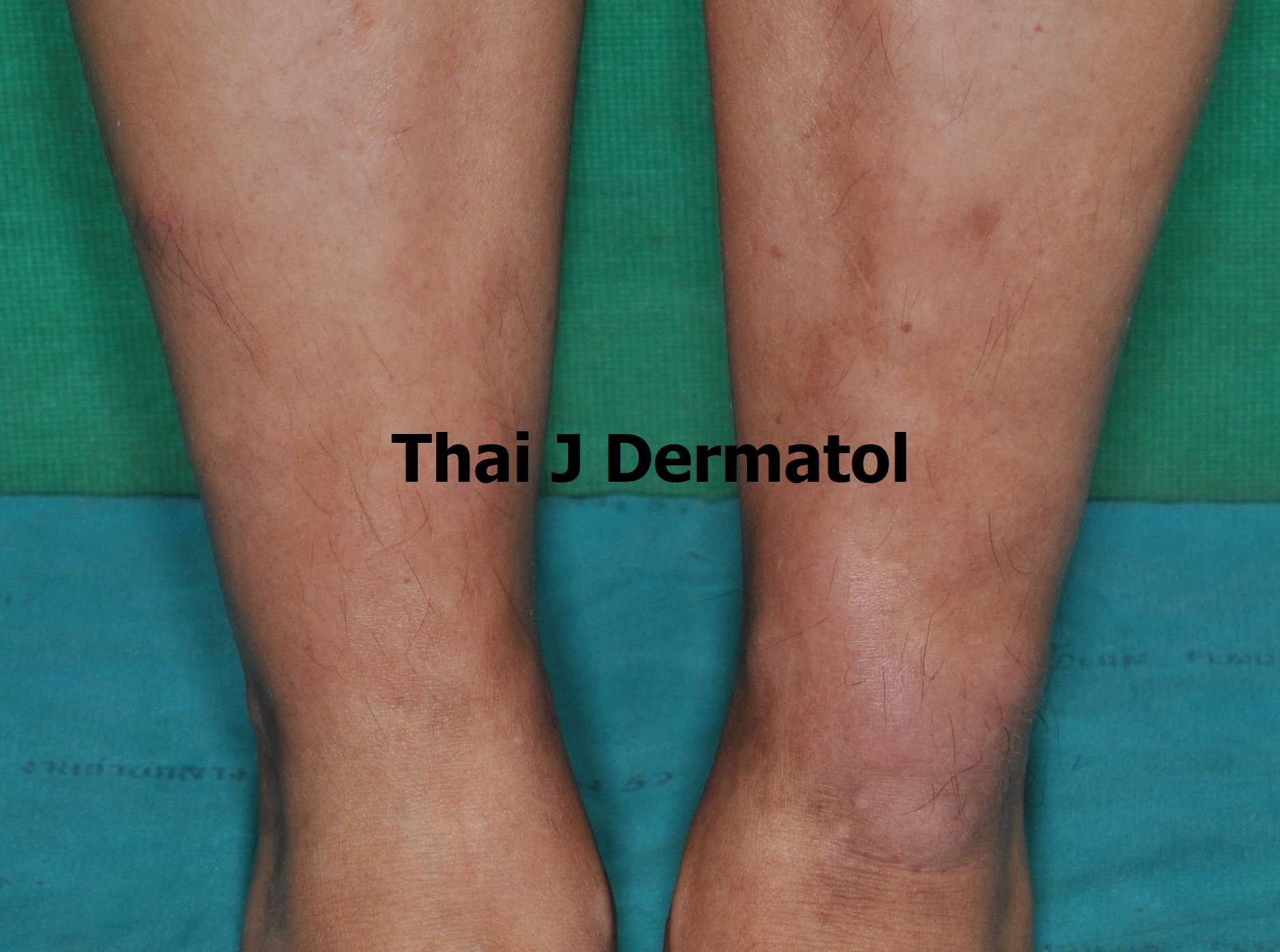Nodular Pretibial Myxedema with Graves’ Disease: A Case Report
Keywords:
Pretibial myxedema, Graves’ diseaseAbstract
Pretibial myxedema is one of the classic clinical triad of Graves’ disease, along with diffuse thyroid gland enlargement and exophthalmos. It is characterized by cutaneous induration due to mucin deposition and typically occurred on extensor surfaces of the legs. The pathogenesis of localized dermopathy is still not fully understood, but it is most likely due to dermal fibroblasts stimulation caused by anti-thyroid stimulating hormone (TSH) antibodies, resulting in excessive production of glycosaminoglcans and hyaluronic acid. Other trigger factors include trauma, smoking, and obesity. There are five distinct clinical variants for pretibial myxedema including the typical diffuse and non-pitting edema form, plaques form, nodular form, mixture form, and the most severe elephantiasis form. Although cutaneous lesions can persist even with effective treatment for thyroid, supportive and symptomatic treatment may be considered. In this case report, we report a case of bilateral pretibial myxedema with an uncommon nodular variant with improvement after intralesional corticosteroids was administered.
References
Fatourechi V. Pretibial myxedema: pathophysiology and treatment options. Am J Clin Dermatol 2005;6:295-309.
Schwartz KM, Fatourechi V, Ahmed DD, Pond GR. Dermopathy of Graves' disease (pretibial myxedema): long-term outcome. J clin Endocrinol Metab 2002;87:438-46.
Lan C, Wang Y, Zeng X, Zhao J, Zou X. Morphological Diversity of Pretibial Myxedema and Its Mechanism of Evolving Process and Outcome: A Retrospective Study of 216 Cases. J thyroid Res 2016;2016:2652174.
Salvi M, De Chiara F, Gardini E, Minelli R, Bianconi L, Alinovi A, et al. Echographic diagnosis of pretibial myxedema in patients with autoimmune thyroid disease. Eur J Endocrinol 1994;131:113-9.
Bartalena L, Fatourechi V. Extrathyroidal manifestations of Graves' disease: a 2014 update. J Endocrinol Invest 2014;37:691-700.
Khalilzadeh O, Mojazi Amiri H, Tahvildari M, et al. Pretibial myxedema is associated with polymorphism in exon 1 of CTLA-4 gene in patients with Graves' ophthalmopathy. Arch dermatol Res 2009;301:719-23.
Davies TF. Trauma and pressure explain the clinical presentation of the Graves' disease triad. Thyroid 2000;10:629-30.
Georgala S, Katoulis AC, Georgala C, Katoulis EC, Hatziolou E, Stavrianeas NG. Pretibial myxedema as the initial manifestation of Graves' disease. J Eur Acad dermatol Venereol 2002;16:380-3.
Cohen BD, Benua RS, Rawson RW. Localized myxedema involving the upper extremities. Arch Intern Med 1963;111:641-6.
Forgie JC, Highet AS, Kelly SA. Myxoedematous infiltrate of the forehead in treated hypothyroidism. Clin Exp dermatol 1994;19:168-9.
Wright AL, Buxton PK, Menzies D. Pretibial myxedema localized to scar tissue. Int J Dermatol 1990;29:54-5.
Pujol RM, Monmany J, Bagué S, Alomar A. Graves' disease presenting as localized myxoedematous infiltration in a smallpox vaccination scar. Clin ExpDermatol 2000;25:132-4.
Siegler M, Refetoff S. Pretibial myxedema--a reversible cause of foot drop due to entrapment of the peroneal nerve. N Engl J Med 1976;294:1383-4.
Fatourechi V. Thyroid dermopathy and acropachy. Best Pract Res clin Endocrinol Metab 2012;26:553-65.
Smith TJ, Hegedüs L. Graves' Disease. N Eng J med 2016;375:1552-65.
Rongioletti F, Robora A. Cutaneous mucinoses: microscopic criteria for diagnosis. Am J dermatopathol 2001;23:257-67.
Burch HB, Cooper DS. Management of Graves Disease: A Review. JAMA 2015;314:2544-54.

Downloads
Published
How to Cite
Issue
Section
License
เนื้อหาและข้อมูลในบทความที่ลงตีพิมพ์ในวารสารโรคผิวหนัง ถือเป็นข้อคิดเห็นและความรับผิดชอบของผู้เขียนบทความโดยตรงซึ่งกองบรรณาธิการวารสาร ไม่จำเป็นต้องเห็นด้วย หรือร่วมรับผิดชอบใดๆ
บทความ ข้อมูล เนื้อหา รูปภาพ ฯลฯ ที่ได้รับการตีพิมพ์ในวารสารโรคผิวหนัง ถือเป็นลิขสิทธิ์ของวารสารฯ หากบุคคลหรือหน่วยงานใดต้องการนำทั้งหมดหรือส่วนหนึ่งส่วนใดไปเผยแพร่ต่อหรือเพื่อกระทำการใดๆ จะต้องได้รับอนุญาตเป็นลายลักอักษรจากบรรณาธิการวารสารโรคผิวหนังก่อนเท่านั้น


